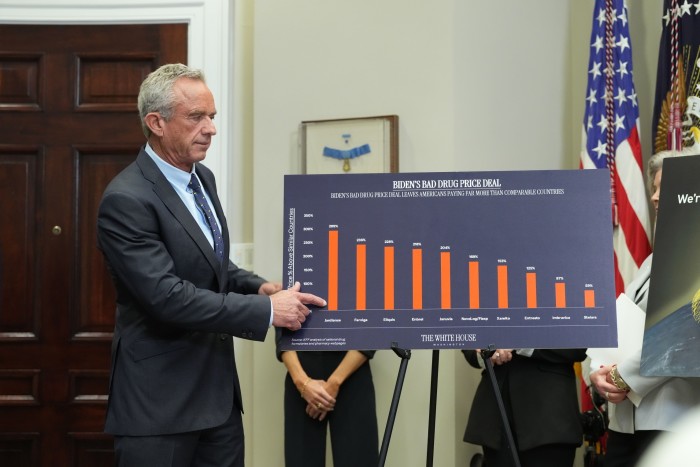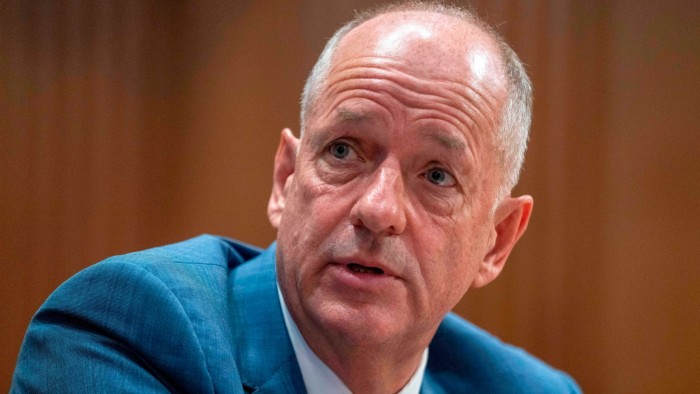Trump leans left in bid to revive flagging poll numbers

Unlock the White House Watch newsletter for free
Your guide to what Trump’s second term means for Washington, business and the world
Donald Trump won last year’s election on a pledge to rid America of radical leftists but on Monday he was adopting some of their policies.
As the president ordered pharmaceutical companies to slash US drug prices on Monday, his Republican health secretary admitted there were clear echoes of Democratic Senator Bernie Sanders in the president’s plan.
“This was the fulcrum of Bernie Sanders’ runs for the presidency,” Robert F Kennedy Jr said, referring to the veteran legislator from Vermont. “I have a couple of kids who are Democrats [and] big Bernie Sanders fans, and when I told them this was going to happen, they had tears in their eyes.”
The inspiration from the populist left is not confined to Trump’s effort to reduce the soaring cost of medicine in America.
In recent weeks, he has grabbed policies typically championed by progressive Democrats — ranging from higher taxes on the very rich to stricter price-gouging enforcement — and made them his own, to the discomfort of many in his own party.
“I think Trump realises that these things are popular and he’s a guy that likes to be popular,” said Liz Pancotti, managing director of policy and advocacy at Groundwork Collaborative, a left-leaning economic think-tank, and a former Sanders aide on Capitol Hill.
Trump’s shift in certain areas of tax and health policy has come as his poll numbers droop over his handling of the economy and the severe market whiplash from his tariff plans, which he has been rapidly rolling back.
He may also be looking to defuse Democratic attacks ahead of the 2026 midterm elections. During Trump’s first term, Democrats regained their majority in the House of Representatives by criticising the president and his party for giving giant tax cuts to the wealthy while seeking to slash healthcare access for middle- and lower-income Americans — a fate the president will want to avoid in his second term.
But the change also reflects a broader drive by Trump to recast the Republicans as the party of the working class rather than of business — a transformation that began during his first term but is more pronounced during his second.
Last week, the president said he would support increasing the top income tax rate for individuals earning more than $2.5mn per year to 39.7 per cent from 37 per cent, defying his party’s traditional opposition to any tax increases.
“It’s really a redistribution, and I’m willing to do it if they want,” Trump told reporters in the Oval Office. “I would love to be able to give people in a lower bracket a big break by giving up some of what I have.”
Earlier in the year, Trump backed the elimination of preferential tax treatment for private equity and hedge fund profits — known as “carried interest” — in a shot across the bow of Wall Street.
With Monday’s executive order on drug prices, he threatened to impose several measures that would also be anathema to Republicans, among them export controls for pharmaceutical companies that sell their products in countries with lower drug prices.
Trump also said the Federal Trade Commission should be ready to take “enforcement action” to tackle any “anti-competitive” behaviour in the sector.
Sanders seemed to endorse the action from the White House. “I agree with President Trump: It is an outrage that the American people pay, by far, the highest prices in the world for prescription drugs,” the Vermont senator said in a statement.
“But let’s be clear,” he added. “The problem is not that the price of prescription drugs is too low in Europe and Canada. The problem is that the extraordinarily greedy pharmaceutical industry made over $100bn in profits last year by ripping off the American people.”
Trump has always had a populist economic streak. It has largely shone through in his protectionist trade policies but is now becoming more evident in other areas.
During the 2024 presidential race against Kamala Harris he proposed a series of tax measures — including the elimination of income tax on tips and overtime work — that aimed to support lower- and middle-class Americans.
But his campaign also bashed Harris for “price controls” and “socialism” when she proposed measures to control grocery costs that included a federal price-gouging ban similar to his latest threats to the drug companies.
Whether Trump’s embrace of Sanders-style populism endures will become evident later this year if he sticks to his plan to crack down on pharma companies and if he is able to get his preferred tax measures — including high taxes on the wealthy — through Congress.
“I don’t think the centre of gravity within the Republican party has moved on whether higher taxes are good. What has changed is the willingness of Republicans to go along with some of these policies that have been strongly associated with Democrats,” said Michael Strain, an economic policy analyst at right-leaning think-tank the American Enterprise Institute.
For now, Trump’s economic plans — which include wide-ranging tax reductions and deep spending cuts to government programmes that help lower-income families — are still disproportionately beneficial to high- income households and harmful to the rest of Americans, so his populism remains mostly performative, say critics.
“If populism is a horseshoe he sometimes has gone up all the way to the right edge of that,” said Pancotti. “[But] it’s tough for me to say we have a populist president when in fact the policies he’s actually putting into place are largely at odds with his rhetoric.”



